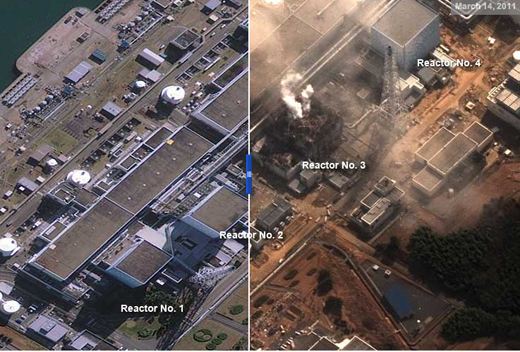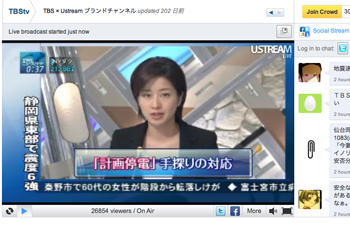The reports and pictures of the devastation from the earthquake and tsunami in Japan last week reminded me of reporting on the earthquake that leveled Japan’s port city of Kobe in 1995.
On a personal level, I am praying for the people in a country I have come to see as a second home.
As a media observer, what struck me this time was how rich and multifaceted the information flow was. In 1995, I worked in the AP bureau in Tokyo, trying to understand what I could from Japanese broadcast news reports. We were sometimes able to reach someone, official or not, in the Kobe region via phone for a quick interview as the death toll rose, eventually reaching more than 6,400.
We, of course, covered the major news conferences held by agencies and government offices. For information from the region, I relied largely on the reporters and photographers (including me three weeks and then six months after the quake) who were dispatched to the scene. Listening to and watching the broadcast channels and the other wire services was an overwhelming and chaotic but — by today’s standards — thin experience.
Multi-platform Experience Today
The past few days, sitting at home and in my office in New York, it felt like I had more information and contacts at my fingertips than I did then as a reporter in Japan. The morning I learned of the quake, I had a TV connected to digital cable, an iPad, a Blackberry and a web-connected computer in my living room.
I flipped among ABC, NBC, MSNBC, Fox, CNN, and BBC on TV. An iPad app gave me video of quake alerts in English and other languages from Japanese national broadcaster NHK. I dipped into the Twitter and Facebook streams.
A photo slideshow on the front page of the New York Times only a few hours after the quake gave a sense of not just the depth of destruction but also the geographic breadth. The towns being mentioned in captions spanned multiple prefectures (similar to states).
I was able to watch Japanese TV network TBS live via a Ustream link I was referred to in a “Japan Quake” page assembled by my New York-based friend and media colleague Sree Sreenivasan.
Huge Amounts of Video
The sheer amount of video — from a country that may have more cameras and camera-equipped cell phones than any other per capita — was so much greater than ever in the TV-only era. Even on TV, I saw constantly updated videos among the various channels, rather than the same loop of packaged videos used in an earlier era.
TV anchors such as Christiane Amanpour, Shepard Smith and Anderson Cooper all are doing shows live from Japan. If it seemed crass that some American networks quickly moved to a branded logo and dramatic music for their quake coverage, it was also intriguing how they now used reports from people talking via webcams.
One Westerner who spoke English with an American accent sat in his Japanese apartment and showed the cup of noodles and the Dole pineapple juice he had had for dinner 11 hours earlier and said he didn’t know what else he’d be able to eat.
The technology also allowed everyone to see video I would have been able to see only as a news editor back then.
On Facebook, my stepmother from California, shared a six-minute video from Asahi TV that I’d seen clips of on TV. It showed water rushing through the streets of one town. With the natural sound, it had that much more impact than with newspeople talking over it. The surprisingly calm expressions on the faces of bystanders watching from high ground puzzled both my stepmother and me, and was something I didn’t see in the multiple TV clips I had seen pulled from this video.
Soon after the quake, I got a hold of one Tokyo resident, one of my best friends, via a Skype connection to his cell phone in Osaka, where he was traveling on business. He said people there had felt the quake but that life was basically unchanged in Japan’s second-largest city.
Updates on Facebook, Twitter
I confirmed that another close friend, an American who is a highly skilled translator in Tokyo, was fine by reading her Facebook wall. There, she also posted constant updates that told all her “friends” the latest reports she was seeing and hearing, as well as her feelings and what she could see with her own eyes. I could see that yet another friend was OK by reading her bylines in AP reports.
A decent amount of the Twitter stream, especially in Japanese, was not very useful in an informational sense; there were exclamations of relief or horror, or strange exclamations that seemed almost senseless. But there were also referrals to data, reports, information I could tap into quickly.
I learned, and was able to confirm, that this was either the 5th or 6th largest quake in recorded history, that a nuclear plant was having trouble with its coolant, that 200-300 people had died in one area, that a bunch of new cars were washed from a port.

Satellite imagery combined with Google Earth technology let many news organizations show overhead images of how towns looked before the tsunami, then after they been flooded.
Shared Details Could be Gut-Wrenching
Sometimes the little details were the most heart-wrenching, such as when a broadcaster droned the numbers of dead town by town, or when my friend on Facebook told us of the man who was riding his bicycle around with a note pinned on it about his missing wife. Here’s that report from NHK via CNN:
The combination of reports provided details that gave a sense of daily life in the affected regions that in the pre-web era I never would have had living overseas, no matter how good a correspondent’s reports.
By watching the live stream of TBS on Monday, for example, I learned that gas was being rationed at one station where motorists had to wait 30 minutes to get in line; heard a woman in a store complain she’d been looking for batteries but couldn’t find them anywhere; and heard another express relief that one store’s shelves had some instant ramen noodles. I learned details of how planned blackouts instituted to conserve electricity would take effect as a stream of related tweets moved by on the side.
Some things were much the same as in 1995: the weak pronouncements of government officials who seemed reluctant to say anything meaningful; the frustration of victims angry at not being told what to do or where to go; the sense of foreboding as the death count continued to rise.
I knew from my Kobe experience that the couple hundred pronounced dead in the initial reports would grow by orders of magnitude. I had seen Japanese reports of entire neighborhoods, even villages, that were “missing” after the mid-afternoon tsunami.
This time the feeling of being connected was much stronger, even though I was thousands rather than hundreds of miles away.
Some connections were possible this time only because of technology. I was able to observe New Jersey-based relatives of my Tokyo-based translator friend express love and relief that she and her family in Japan were safe. My friends in the U.S. and elsewhere used Facebook, Twitter and text messages to ask me about my loved ones in Japan, which let me reply in a way that was much easier to handle than in the previous era.
The media and communication technology of course do not change the scope of the disaster but do change the way we are able to experience and share it.
Resources like the Google People Finder in Japanese and English, links to aid sites, like the one on this WNYC.org page, and some social media outreach may have even changed things in a more fundamental way.
I do hope the pain and struggles of people affected are mitigated by knowing their plight can be seen and understood in a richer way, and by help they may receive more easily because of new technologies.
A former managing editor at ABCNews.com and an MBA, Dorian Benkoil handles marketing and sales strategies for MediaShift. He is SVP at Teeming Media, a strategic media consultancy focused on attracting, engaging, and activating communities through digital media. He tweets at @dbenk.

